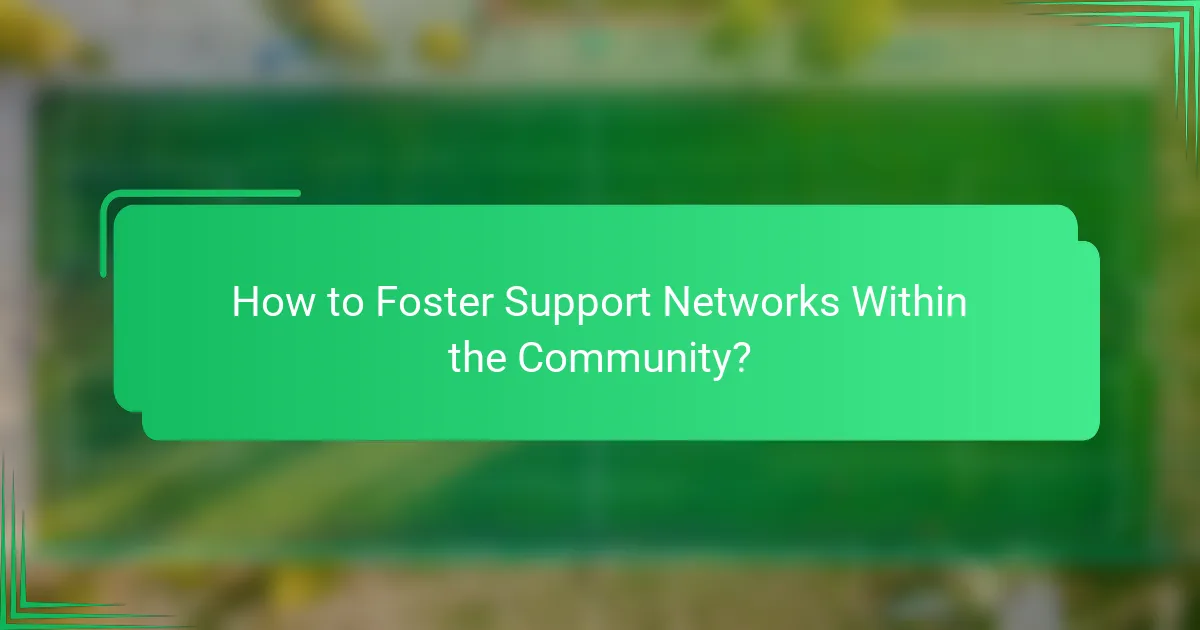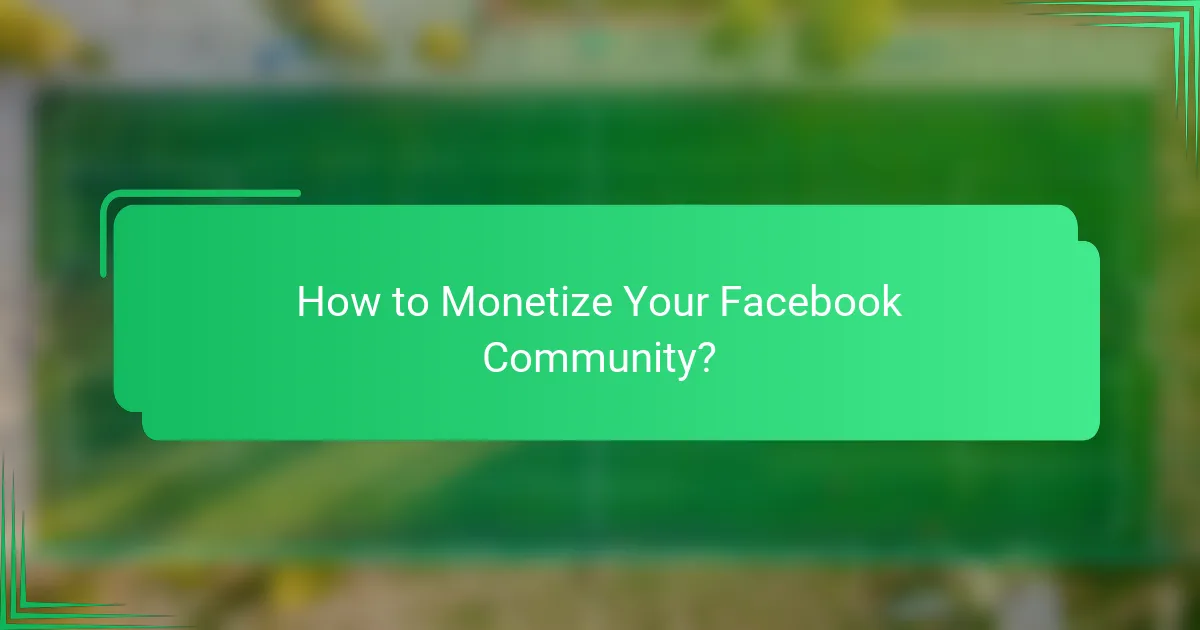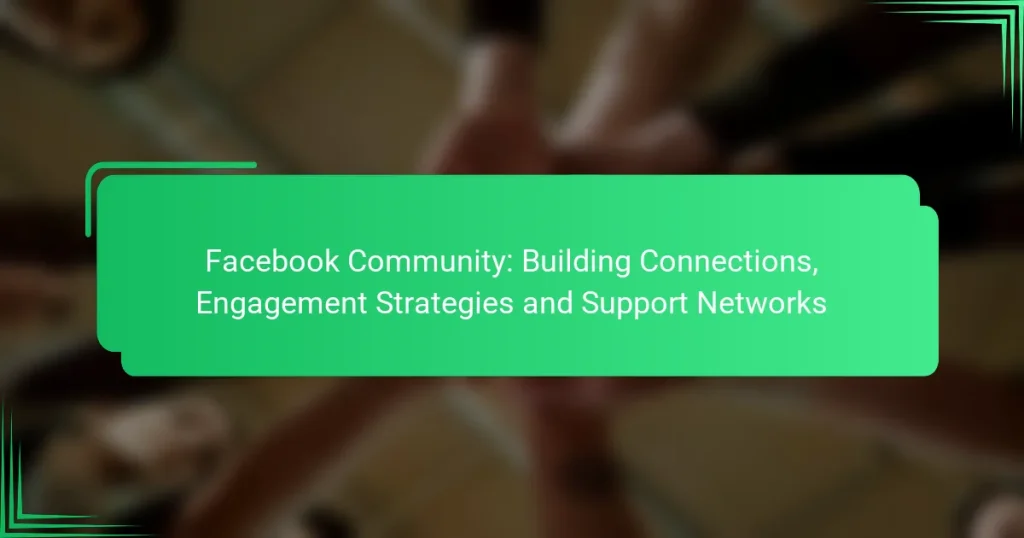Building a Facebook community effectively requires creating an engaging space where members feel connected and valued. By focusing on clear objectives and understanding your audience, you can leverage Facebook’s features to enhance interaction and foster meaningful relationships. Additionally, establishing support networks within the community encourages members to share, seek help, and connect, ultimately enriching the overall experience.

How to Build a Facebook Community Effectively?
Building a Facebook community effectively involves creating a space where members feel connected and engaged. Focus on clear objectives, understanding your audience, and leveraging Facebook’s features to foster interaction.
Define your community’s purpose
Clearly defining your community’s purpose sets the foundation for engagement. Consider what topics or interests will unite members and what goals you want to achieve, such as sharing knowledge, providing support, or networking.
For example, a community focused on local hiking enthusiasts might aim to share trails, organize group hikes, and exchange gear recommendations. This clarity helps attract like-minded individuals who share similar interests.
Identify target audience demographics
Understanding your target audience’s demographics is crucial for effective community building. Consider factors like age, location, interests, and online behavior to tailor your content and engagement strategies.
For instance, a community for young professionals in a specific city may focus on career development and networking opportunities, while a group for parents might emphasize parenting tips and local events. Knowing your audience helps create relevant discussions.
Choose the right group type
Selecting the appropriate group type on Facebook is essential for achieving your community’s goals. You can choose between public, closed, or secret groups, each offering different levels of visibility and privacy.
Public groups allow anyone to join and view content, while closed groups require approval for membership but keep discussions private. Secret groups are only visible to invited members. Choose based on how open or exclusive you want your community to be.
Utilize Facebook group features
Facebook offers various features to enhance community interaction, such as polls, events, and announcements. Use these tools to encourage participation and keep members informed about upcoming activities or discussions.
For example, creating regular polls can help gauge member interests and preferences, while events can facilitate real-life meetups or online discussions. Regularly utilizing these features keeps the community dynamic and engaging.
Promote your community outside Facebook
To grow your Facebook community, promote it through other channels such as social media, blogs, or newsletters. Share links and invite people to join, emphasizing the benefits of being part of the group.
Consider collaborating with influencers or related communities to reach a wider audience. For instance, if your community focuses on fitness, partnering with local gyms or health bloggers can attract new members who share similar interests.

What Engagement Strategies Work Best?
Effective engagement strategies for Facebook communities focus on fostering interaction, building relationships, and providing value. Prioritizing member participation and consistent communication can significantly enhance community dynamics.
Encourage member participation
Encouraging member participation is crucial for a vibrant Facebook community. Create opportunities for members to share their thoughts, experiences, and questions. This can be achieved through open-ended posts, where members are invited to comment or share their stories.
Consider recognizing active participants with shout-outs or rewards, which can motivate others to engage. Setting clear guidelines for participation can also help maintain a respectful and welcoming atmosphere.
Host regular events and discussions
Regular events and discussions can significantly boost engagement in your community. Schedule weekly or monthly live sessions, Q&A events, or themed discussions that encourage members to participate and interact with one another.
Promote these events in advance to maximize attendance, and consider using Facebook Live or group video calls to create a more personal connection. Following up with a summary or highlights can keep the conversation going even after the event ends.
Share valuable content consistently
Consistently sharing valuable content is essential for keeping community members engaged. Focus on content that addresses their interests, challenges, and needs, such as tips, tutorials, or industry news. Aim for a mix of formats, including articles, videos, and infographics.
Establish a content calendar to ensure regular posting and maintain a balance between promotional and informative content. Engaging visuals and clear calls to action can enhance the effectiveness of your posts.
Utilize polls and surveys
Polls and surveys are effective tools for gauging member interests and preferences. Use them to gather feedback on community topics, event ideas, or content preferences. This not only involves members in decision-making but also provides insights that can guide your engagement strategies.
Keep polls simple and quick to complete, ideally with a few options to choose from. Sharing the results and how they will influence future content can further encourage participation and show members that their opinions matter.

How to Foster Support Networks Within the Community?
Fostering support networks within a community involves creating an environment where members feel safe to share, seek help, and connect with one another. This can be achieved through clear guidelines, recognition of achievements, and the provision of valuable resources.
Establish guidelines for support
Establishing clear guidelines for support helps set expectations and creates a safe space for members. These guidelines should outline acceptable behaviors, confidentiality, and how to approach sensitive topics. For example, you might encourage members to respect each other’s privacy and to offer constructive feedback.
Consider creating a document that outlines these guidelines and pinning it in a prominent place within the community. Regularly revisiting and updating these guidelines can also help maintain a supportive atmosphere as the community evolves.
Highlight member achievements
Recognizing and celebrating member achievements fosters a sense of belonging and encourages engagement. This can be done through shout-outs in community posts, dedicated threads, or monthly highlights. For instance, you could feature a “Member of the Month” to showcase contributions and successes.
Encouraging members to share their own milestones can also enhance connection. Create a space where individuals can post about their achievements, big or small, to inspire and motivate others.
Provide resources and tools
Providing resources and tools is essential for empowering community members. This could include access to educational materials, workshops, or online tools that facilitate connection and support. For example, consider offering webinars on relevant topics or creating a resource library with articles and guides.
Additionally, consider collaborating with local organizations or experts to provide workshops or Q&A sessions. This not only enriches the community but also strengthens the support network by connecting members with external resources.

What Metrics Should You Track for Community Success?
To measure community success on Facebook, focus on key metrics such as member growth rate, engagement levels, and content reach. These metrics provide insights into how well your community is thriving and interacting with its members.
Member growth rate
Member growth rate indicates how quickly your community is expanding. A healthy growth rate typically falls between 5-10% monthly, depending on the niche and engagement strategies employed. Tracking this metric helps identify effective outreach and promotional tactics.
To calculate the growth rate, use the formula: ((New Members – Lost Members) / Total Members at Start) x 100. Regularly analyze this data to adjust your strategies and maintain a steady influx of new members.
Engagement levels
Engagement levels reflect how actively members participate in discussions and activities within the community. High engagement is often characterized by a mix of likes, comments, shares, and posts, ideally aiming for an engagement rate of 10-20% of total members.
To enhance engagement, encourage discussions, ask questions, and create polls. Monitor which types of content generate the most interaction to refine your approach and keep members involved.
Content reach and visibility
Content reach and visibility measure how many people see your posts and how often they engage with them. Aim for a reach that exceeds 20% of your total member count to ensure your content is effectively reaching your audience.
Utilize Facebook Insights to track reach metrics and adjust your posting times, frequency, and content types accordingly. Experiment with different formats, such as videos or live sessions, to increase visibility and attract more interactions.

How to Monetize Your Facebook Community?
Monetizing your Facebook community involves leveraging your audience to generate income through various strategies. Key methods include affiliate marketing and sponsored content, which can effectively turn engagement into revenue.
Affiliate marketing opportunities
Affiliate marketing allows you to earn commissions by promoting products or services relevant to your community. By sharing unique links, you can track sales generated through your recommendations, typically earning a percentage of each sale.
To succeed, choose affiliate programs that align with your community’s interests. Popular platforms like Amazon Associates or ShareASale offer a wide range of products, making it easier to find suitable options. Aim for products that resonate with your audience to increase conversion rates.
Sponsored posts and partnerships
Sponsored posts involve collaborating with brands to create content that promotes their products or services in exchange for payment. This can be a lucrative way to monetize your community if the partnerships are authentic and relevant.
When considering sponsored content, ensure that it aligns with your community’s values and interests. Transparency is crucial; always disclose sponsored posts to maintain trust. Establishing long-term partnerships with brands can lead to more consistent income and deeper engagement with your audience.


